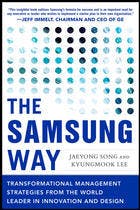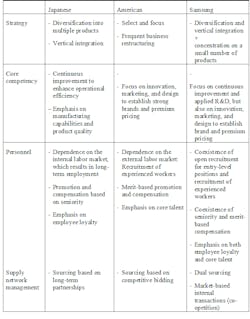What is the Samsung Way?
How did Samsung became a household name? “Samsung went from a no-name company in the global market of the early 1990s to a world-class corporation in the second millennium,” explains Dr. Jaeyong Song, lead author of the just released book The Samsung Way.
In 2013 Samsung Electronics (IW 1000/14), the flagship company of the Samsung Group, had revenues of $34 billion. Song points out that this revenue surpasses HP ( IW 500/9), Siemens (IW 1000/35) and Apple (IW 500/4).
Additionally, since 2006 the company has ranked second, only behind IBM (IW 500/11), in patent registration.
And in brand recognition (Interband’s Global Brand Rankings), Samsung is the highest-ranking non-American company.
IndustryWeek posed a few questions to Dr. Song to understand the underpinnings of this transformation so that other manufacturers might replicate the success.
IW: How did Samsung transform itself from a mediocre OEM manufacturer to a world-class performer in just 20 years?
JS: The most important factor in Samsung's success was the New Management Initiative Chairman Lee proposed in 1993. At the time, Chairman Lee was very concerned about Samsung’s lack of competitiveness in the global marketplace. The emerging trends in the 1990s, such as globalization, Korea’s democratization, and digitization encouraged Chairman Lee to take a bold transformation initiative.
Most importantly, Chairman Lee viewed the emerging digital revolution as a golden opportunity to get ahead of Japanese electronics giants such as Sony. These Japanese companies were winners in the existing analog technologies and were thus reluctant to adopt disruptive digital technologies quickly.
The New Management Initiative had the ambitious goal of making Samsung one of the leading global companies of the twenty-first century. In order to achieve this goal Chairman Lee spearheaded a complete corporate transformation of Samsung. Chairman Lee proposed a famous New Management slogan, “Change everything except your wife and children.”
Initially, most Samsung employees did not understand why Samsung had to change so radically. So they only wanted to change their wives. But Chairman Lee was persistent enough to push forward massive change management throughout the 1990s, re-aligning every aspect of Samsung’s management system to its new quality-driven goal. In particular, Chairman Lee pushed Samsung to invest preemptively in R&D, brand marketing, and design capabilities for emerging digital products.
The outcomes of the New Management initiative were astounding. Since 2004, the operating profits of Samsung Electronics have consistently been higher than the sum of the annual operating profits of Japan’s five major electronics companies, including Sony and Panasonic.
Role of Partnerships
IW: Part of the company's success was to move into partnerships with other large companies such as HP and IBM and take an equal partnership role. Why was this decision made and what was the affect in terms of the company's competitive position?
JS: Since Samsung was a latecomer which lacked core technologies, the company had strong incentives to form partnerships with industry leaders such as HP, IBM, and Microsoft to get access to technologies. Relying solely on internal development was not a viable option.
However, Samsung absorbed technologies from its partners quickly and developed its own technologies by making aggressive investments in its internal R&D capabilities.
As Samsung developed its own world-class competencies that turned out to be valuable for these industry leaders, it has taken an equal partnership role over time. The equal partnership with these global leaders enhanced Samsung's status to the global premier level. Moreover, by signing cross licensing agreements of patents with these global firms, Samsung was able to develop and sell premium products.
Hybrid Management System
IW: In the process of creating a hybrid management system that incorporates Japanese, U.S. and Korean styles of management, what strengths of each were ultimately chosen?
JS: Samsung’s management style is a hybrid of the best from the Japanese and American approaches to management (Korean style of management in the early 1990s was very similar to Japanese style of management). The company’s excellent learning capabilities have been used to optimize the best aspects of both management styles for many years.
Generally, Japanese management is characterized by market share orientation, unrelated diversification, vertical integration, emphasis on manufacturing competitiveness and operational efficiency, strict organizational discipline, emphasis on employee loyalty, internal and seniority-based promotion and rewards, and participation of both workers and shareholders in management.
The American management style, on the other hand, emphasizes profits and revenue, focusing on relevant industries and frequently restructuring businesses and products. American companies also tend to outsource manufacturing or move abroad, finding the source of their core competencies in soft capabilities or intangible assets such as technological innovation, brand marketing capabilities, and design capabilities.
ompared to Japanese companies, American businesses are typically more centralized, and because they value core talent with differentiated competencies more than the loyalty of executives and employees, they depend more on external labor markets than on internal cultivation of labor. As a result, short-term employment, thorough assessments and promotions, and employees who specialize in a particular area, are common in U.S. workplaces.
Samsung’s vertical and horizontal diversification, emphasis on manufacturing competitiveness and product quality, open competitive recruitment for entry-level positions, intensive employee training to develop a standardized workforce, strict organizational discipline, and emphasis on organizational loyalty all resemble Japanese-style management.
However, Samsung’s management style also resembles American-style management in many ways. The strategies and personnel policies of Samsung headquarters exemplify this similarity. Frequent restructuring, emphasis on soft capabilities (technology, brand, and design), talent recruitment, excellent performance-based compensation, and risk-taking CEOs are all evident in Samsung businesses. These are all characteristic of American management.
Samsung incorporated the strengths of both the Japanese and American styles into its own management system through vigorous benchmarking. After a lengthy process of research and experimentation, Samsung then tailored both management styles for its own management system to create a form of management that is unique to Samsung.
This process has been an ongoing effort for decades as Samsung has grown. It is difficult to accommodate the elements of both the Japanese and American management styles into a single company. This is because the elements of either style are organically connected, and cannot be easily disassembled and grafted onto the other.
The co-existence of these two styles within Samsung directly stems from the fact that it runs a business with huge strategic uncertainty while maintaining massive manufacturing facilities. Its flagship IT business is in an industry noted for sharp swings in demand and rapidly changing technologies, thus requiring a high level of strategic foresight.
To survive in such an environment, Samsung has adopted the elements of American management style like bold risk taking, securing core talent, strong performance-based incentives, creative organizational culture, and high speed.
At the same time, Samsung strenuously strives to reduce costs based on the massive manufacturing facilities it has built around the world. Such efforts are powered by the Japanese management style that Samsung built for decades before New Management.
As a result, Samsung’s strategic planning, focused on its CEO system, now mainly uses American practices, while its operations mainly rely on Japanese management practices.
Intangible assets, including technology, branding, and design, have grown in importance in the knowledge-based economy of the 21st century. Reflecting this change, Samsung has reduced its reliance on the Japanese models it adopted in the past, including an emphasis on standardized talent and seniority based compensation, while greatly increasing its use of American practices like an emphasis on core talent, and competencies and performance-based compensation and promotion.
Nonetheless, rather than complete abandonment of existing practices like open recruitment, seniority-based compensation and promotion, and long-term employment, Samsung has maintained their framework to some degree while transplanting American customs of core talent and performance based pay onto the previous structure.
The following table summarizes Japanese, American, and Samsung-style management. This table summarized what strengths of Japanese and U.S. management styles Samsung has ultimately chosen as a basis of Samsung style management.
Japanese, American, and Samsung Style Management
Employee Training Program
IW: As manufacturing companies are trying to retain good workers and attract others, could you talk about the training program at Samsung?
JS: Samsung Human Resource Development Center (SHRDC) has played a critical role in training Samsung's employees. In 2009, the annual budget of the center was about $70 million employing 62 full-time HRD specialists. The center provided 19,620 man/days of training and education to 3105 SEC employees. The number of educational programs, which span foreign languages, business administration, technology, business etiquette, Chinese characters, etc, was over 1000.
SHRDC has also played a crucial role in not only imbuing employees with management practices of world-class companies but also disseminating new management practices. Training and education programs provided by SHRDC have nurtured key managers and executives at Samsung.
For instance, every step forward promotion ladder, candidates who are eligible for promotion usually got one-month, full-time training and education at SHRDC. Each year, about 50 candidates for executive positions for affiliate companies of Samsung went through five month long intensive education program and learnt management practices of world-class companies.
After they are promoted to executive positions, they become agents of implementing new management practices authorized by top management teams and creating culture that is prone to accept westernized management practices.
IW: Could you highlight some specific improvements in manufacturing processes that accounts for the company's success?
JS: Samsung Electronics’ manufacturing efficiency is a major source of its product competitiveness. The starting point of Samsung’s manufacturing capabilities is Samsung’s SCM system and the Global Operations Center (GOC) at each business division.
Since sales and production plans are developed on a 20-week rolling basis, plans are made 20 weeks in advance, and adjustments are made weekly. Every Tuesday afternoon, the GOC sets or revises production plans for each plant, confirming the type and quantity of products to be produced by each worker at each production line and plant three days in advance. This system is strictly followed, as changes in production plans after the three-day lead inevitably cause confusion among partners and undermine efficiency in the entire value chain.
In principle, plants are required to meet the sales offices’ demands when it comes to the types and quantities of products made. However, because it is too complex to decide what 36 plants across the world can produce and what 63 sales offices can sell, Samsung’s production sites are required to meet the demands of the sales offices no matter what they are. More important, Samsung’s underlying philosophy is to strictly follow the needs of the market and of customers. After six months of applying this philosophy, Samsung Electronics was able to supply 98% of the sales offices’ requests, while the sales offices made efforts to forecast sales more accurately.
Samsung’s production motto is “by the book,” meaning that it produces the allotted number of products in the allotted time, and then ships them on the same day. This proved to be an easy goal to meet at the outset, as employees were eager to work overtime to meet production targets. However, since overtime allowances raised labor costs, Samsung set the reduction of overtime as an evaluation criterion the following year. By doing so, Samsung was able to increase its ability to produce the targeted quantity within the allotted time.
Another defining characteristic of Samsung Electronics’ production is its ability to quickly adjust output to meet changing demand for an item. To this end, Samsung has decreased its dependence on traditional fixtures of mass production like the conveyor belt and introduced new production systems like flexible manufacturing that enable the company to produce numerous types of products on a single line, “Lego”-style production (referring to the modular disassembly and reassembly of production lines), and “cell production,” where one worker does all the assembly and quality inspection for a finished product.
Samsung used one-person cell production to particularly strong effect in mobile phones. This process, in which a single worker performs the entire assembly and testing of a smartphone, is used by companies with exceptionally competent workers. Each worker is given a quota based on his or her abilities, and the types of products that the worker is assigned can be changed hourly. Parts are supplied by robots located in the production process as needed to meet the production schedules of workers. Samsung’s integrated production system ensures that parts are supplied and classified based on the individual production schedule of each worker via an automated process, leading to higher productivity and fewer defects compared to competitors who use assembly contractors that rely more on manual labor.
Samsung also uses a block cell production system, in which four to eight workers collectively assemble and test a smartphone. Most of the employees in Samsung’s Vietnam plant work under this system, as they are semiskilled as a result of high turnover rates. Samsung has also outsourced production to independent manufacturers who used the conveyor belt production system.
Dr. Jaeyong Song, and Kyungmook Lee are the authors of the The Samsung Way.


